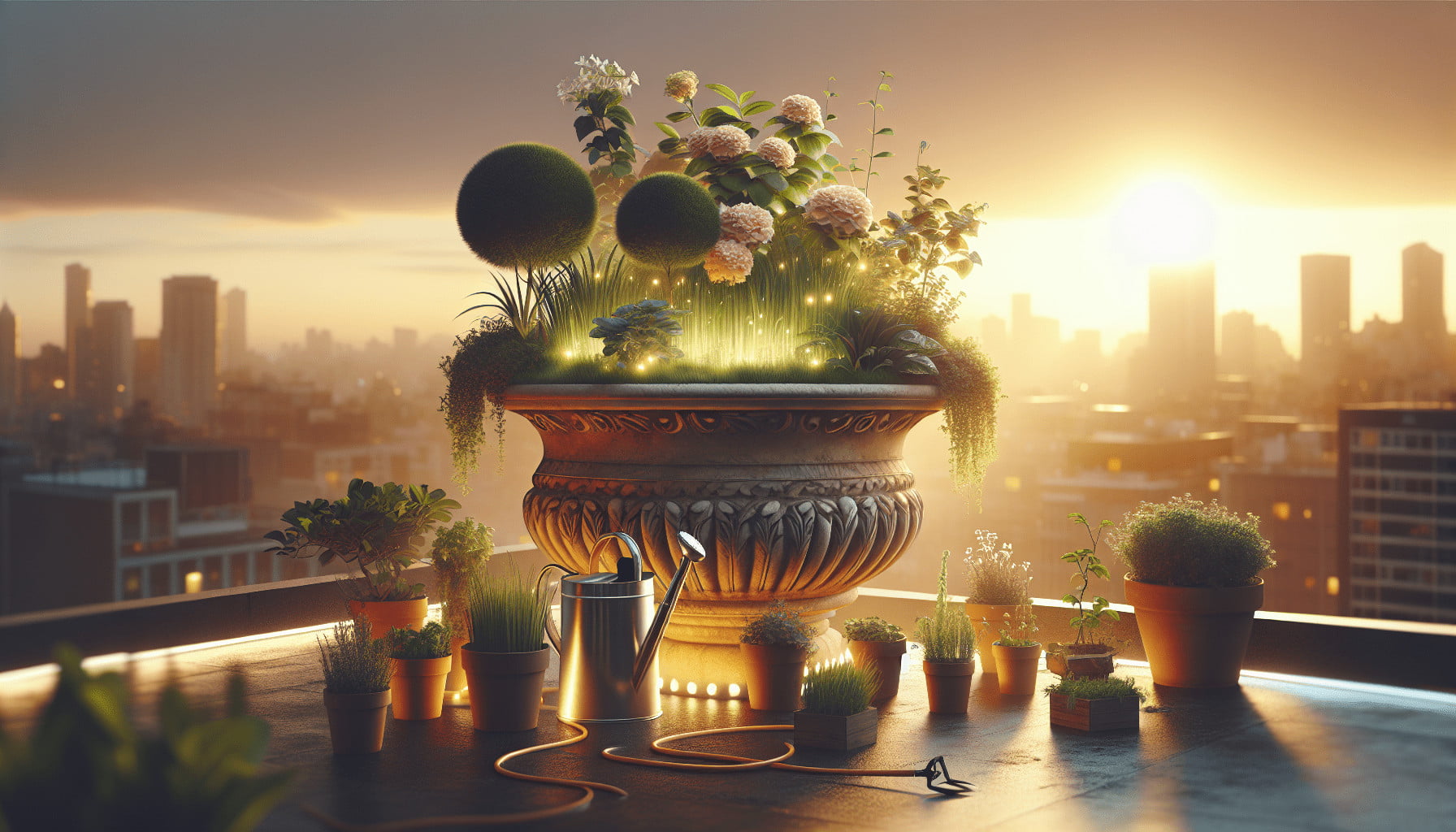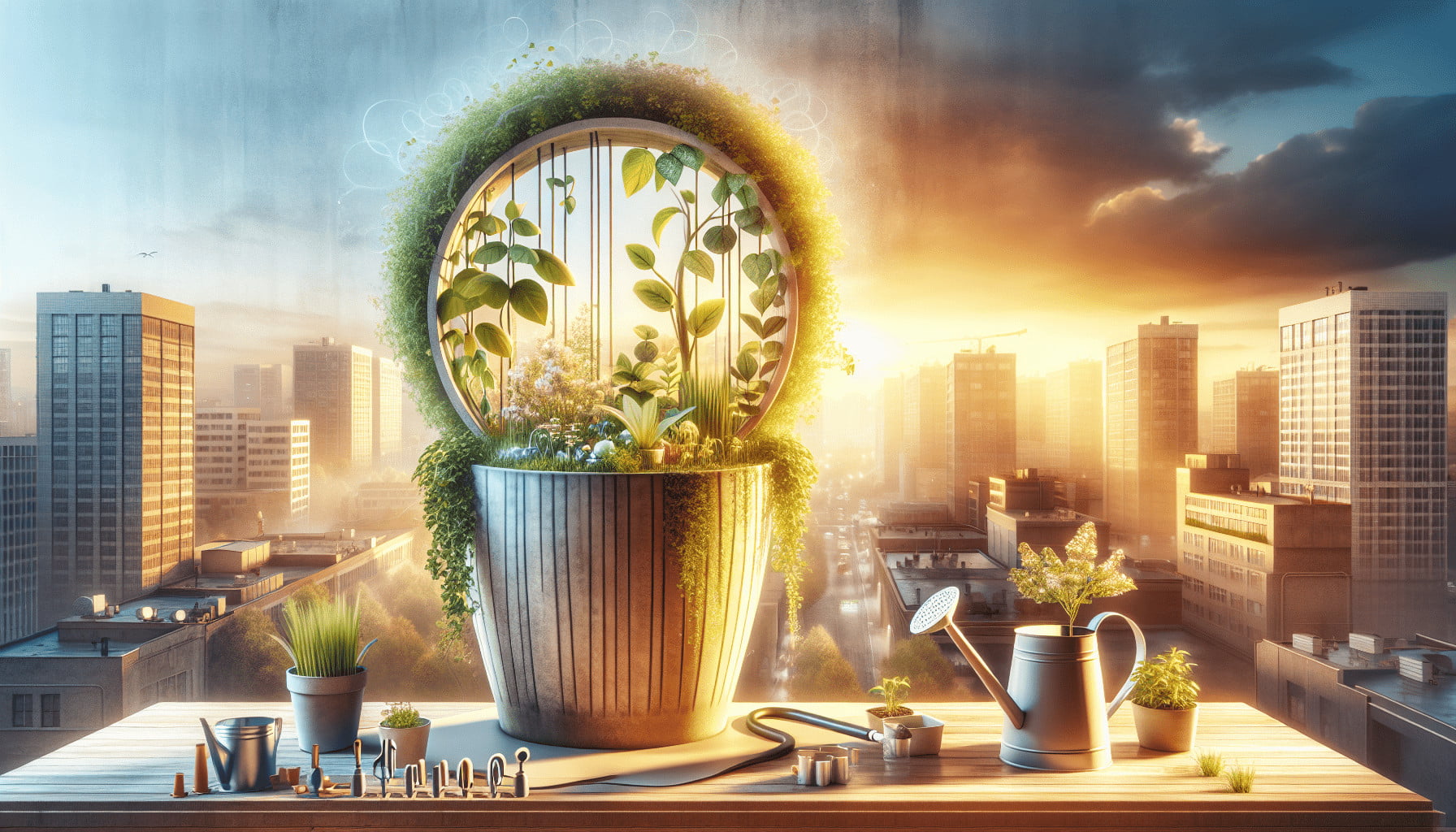Have you ever found yourself wondering how to keep your rooftop container garden thriving, especially through the ups and downs of weather and urban life? Managing a rooftop garden can bring immense joy, but it also comes with unique challenges, especially when it comes to watering. Getting it right can be the difference between a lush, thriving garden and a struggle with wilting plants.
Understanding the Basics of Rooftop Container Gardens
Rooftop container gardens are a fantastic way to bring greenery into urban spaces, but they operate under different rules compared to traditional ground gardens. The combination of elevation, exposure, and limited soil volume requires a tailored approach to care, particularly concerning water management.
Why Rooftop Container Gardens Require Special Attention
Rooftop gardens are exposed to harsher conditions, such as more direct sunlight, stronger winds, and sometimes even more polluted air. These factors contribute to quicker water evaporation and more strain on your plants. Understanding these unique challenges can help you tailor your watering practices to best support your garden’s health.
Tip 1: Choose the Right Containers
The type of container you choose plays a critical role in how your plants will fare, particularly regarding water retention and root health.
Importance of Container Material
Containers come in various materials, each with its pros and cons. Here’s a quick reference table:
| Container Material | Advantages | Disadvantages |
|---|---|---|
| Terracotta | Breathable, prevents root rot | Heavier, dries out quickly |
| Plastic | Lightweight, retains moisture well | Less breathable, can overheat |
| Metal | Durable, sleek look | Can get very hot, may rust |
| Fabric | Very breathable, promotes root health | Dries out quickly, less durable |
Choosing the right material can help you better manage soil moisture levels. For instance, terracotta might be a good choice if you tend to overwater, whereas plastic might be more suitable if you need containers that retain moisture longer.
Size and Shape Considerations
Bigger containers generally hold more soil, which means they can retain water longer. However, they’re heavier and might be challenging to manage on a rooftop. The depth of the container also matters because deep containers allow for more extensive root systems, which can better withstand dry spells.

Tip 2: Use Quality Potting Mix
A high-quality potting mix is crucial for maintaining the right moisture levels in your rooftop garden. The mix should provide proper drainage while also retaining enough water for your plants.
Components of an Ideal Potting Mix
Your potting mix should ideally have:
- Peat moss or coir: These materials help retain water.
- Perlite or vermiculite: These add aeration to the mix, preventing compaction.
- Compost: Provides nutrients and helps with water retention.
- Sand or gravel: Improves drainage.
Experimenting with the right balance can result in a mix tailored specifically to your plants’ needs and your environmental conditions.
Regular Refreshing
Potting mix deteriorates over time, losing its structure and nutrients. Refreshing the top layer annually with compost or fresh potting mix can help maintain healthy soil conditions and improve water retention.
Tip 3: Adopt Smart Watering Practices
When it comes to watering your rooftop garden, being methodical and knowledgeable can make all the difference.
Consistency is Key
Plants generally thrive on consistency. Rather than soaking your plants sporadically, aim for a regular watering schedule that matches your plants’ needs. Sometimes a daily check is necessary, especially during hot, dry periods.
Watering Techniques
Different techniques can be employed to ensure that water reaches the roots and is not wasted. Here are some efficient methods:
- Bottom watering: Place containers in a shallow tray of water, allowing them to absorb moisture through drainage holes.
- Drip irrigation: A drip system can save water and apply moisture directly where it’s needed, reducing evaporation.
- Watering wands: These allow for gentle, targeted watering right at the plant’s base, which prevents splashing and evaporation.
Early Morning or Late Evening Watering
Watering during cooler parts of the day helps reduce water loss due to evaporation and gives plants a chance to absorb moisture before the midday heat.

Tip 4: Utilize Mulch
Mulching is an often-overlooked technique that can make a significant difference in water conservation.
Benefits of Mulching
Mulch helps to:
- Retain moisture by reducing evaporation.
- Insulate the soil, keeping roots cooler during hot weather.
- Suppress weed growth, which can compete with your plants for water.
- Gradually add organic matter to the soil as it decomposes.
Types of Mulch
Several mulching materials are available, each with specific benefits:
| Mulch Type | Pros | Cons |
|---|---|---|
| Organic (e.g., straw, wood chips) | Adds nutrients to soil, improves texture | Can attract pests, needs replenishment |
| Inorganic (e.g., gravel, pebbles) | Long-lasting, decorative | No nutrient benefits, heavier |
| Synthetic (e.g., plastic sheeting) | Excellent water retention, controls weeds | Can affect soil health negatively, less attractive |
Choose the mulch that best fits your garden’s needs and aesthetic.
Tip 5: Monitor and Adjust According to Weather
Rooftop gardens are particularly susceptible to changing weather conditions. Regular monitoring and adjustment are crucial for the health of your plants.
Understanding Seasonal Variations
Each season brings its challenges:
- Spring: Plants are usually in a growth phase and may require more water.
- Summer: High temperatures can lead to rapid evaporation, necessitating more frequent watering.
- Fall: As temperatures drop, plant growth slows, and water needs decrease.
- Winter: Depending on your climate, you might need to water less frequent but still ensure your soil doesn’t completely dry out.
Leverage Rainwater When Possible
Collecting and using rainwater can be an excellent way to maintain your rooftop garden. It’s free, often more beneficial for plants than tap water, and reduces your environmental footprint.
Using Technology for Monitoring
Modern gardening can benefit greatly from technology:
- Soil moisture sensors: These can provide real-time data on soil hydration levels, helping you adjust watering accurately.
- Weather apps: These tools can alert you to upcoming weather changes, allowing you to adjust your watering schedule in advance.
Observing Plant Indicators
Plants themselves can be good indicators of their water needs. Wilting, yellowing leaves, and poor growth can all be symptoms of improper watering. Being observant and reactive to these signs can often prevent minor issues from escalating into major problems.
Conclusion
Caring for a rooftop container garden requires a nuanced approach to watering, tailored to the unique conditions of an elevated, urban environment. By choosing the right containers, using quality potting mix, adopting smart watering practices, utilizing mulch, and adjusting according to weather, you can ensure your rooftop sanctuary thrives.
Balancing these factors may seem daunting at first, but with some attention to detail and a bit of experimentation, you’ll soon develop a rhythm that keeps your garden not just surviving, but flourishing.
So next time you marvel at your rooftop oasis, know that each drop of water, every chosen container, and each layer of mulch contributes to creating an urban garden that’s both a retreat and a testament to your care. Happy gardening!
